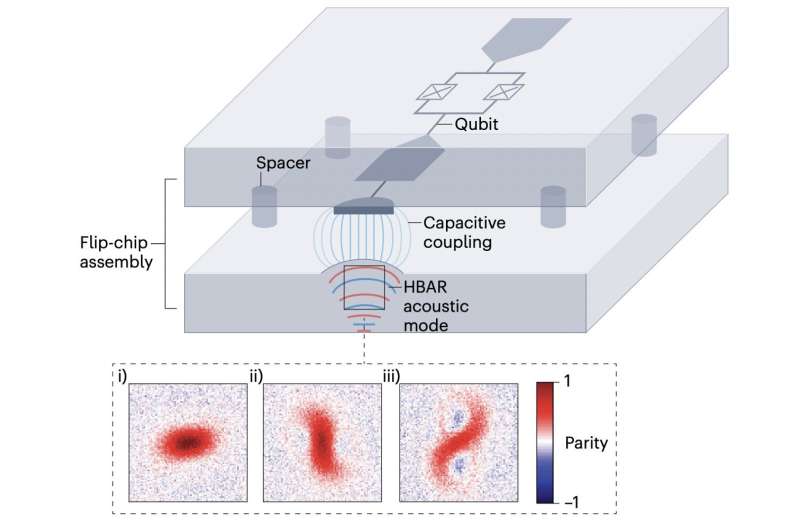July 8, 2024 feature
This article has been reviewed according to Science X's editorial process and policies. Editors have highlighted the following attributes while ensuring the content's credibility:
fact-checked
peer-reviewed publication
trusted source
proofread
A new approach to realize quantum mechanical squeezing

Mechanical systems are highly suitable for realizing applications such as quantum information processing, quantum sensing and bosonic quantum simulation. The effective use of these systems for these applications, however, relies on the ability to manipulate them in unique ways, specifically by 'squeezing' their states and introducing nonlinear effects in the quantum regime.
A research team at ETH Zurich led by Dr. Matteo Fadel recently introduced a new approach to realize quantum squeezing in a nonlinear mechanical oscillator. This approach, outlined in a paper published in Nature Physics, could have interesting implications for the development of quantum metrology and sensing technologies.
"Initially, our goal was to prepare a mechanical squeezed state, namely a quantum state of motion with reduced quantum fluctuations along one phase-space direction," Fadel told Phys.org. "Such states are important for quantum sensing and quantum simulation applications. They are one of the gates in the universal gate set for quantum computing with continuous-variable systems—meaning mechanical degrees of freedom, electromagnetic fields, etc., as opposed to qubits that are discrete-variable systems."
While performing their experiments and trying to attain an increasing amount of squeezing, Fadel and his colleagues realized that after a certain threshold, the mechanical state was becoming more than merely narrower (i.e., more squeezed) and more elongated. In addition, they found that the state started to twist/twirl around itself, following an "S"-like or even "8"- like pattern.
"We did not expect this, as the preparation of non-gaussian states requires significant nonlinearities in the mechanical oscillator, so we were quite surprised, but of course also excited," Fadel explained.
"Typical mechanical nonlinearities are extremely small and typical couplings between mechanical oscillators and light/microwave fields are also linear. However, it was easy to realize that in our device the resonator was inheriting some of the nonlinearity from the qubit it was coupled to."
The researchers found that the nonlinearities the resonator inherited were quite strong, resulting in the fascinating effect they observed. In their recent paper, they showcased this new approach to realize quantum squeezing in this nonlinear mechanical system.
The system employed in the team's experiments consists of a superconducting qubit coupled to a mechanical resonator via a disk made of a piezoelectric material. The coupling between these two systems results in the effective nonlinearity of the resonator.
"When a two-tone drive is applied to the system at the correct frequencies, f1+f2=2*fm (where f1 and f2 are the two-tone drive frequencies and fm the frequency of the mechanical mode), a parametric process takes place: two microwave photons at frequencies f1 and f2 from the drives are converted into a pair of phonons at frequency fm of the mechanics," Fadel said.
"This is very similar to a parametric conversion process in optics, where light fields are sent to a nonlinear crystal that generates squeezing in a similar way as I described."
The new approach for realizing mechanical squeezing introduced by this team of researchers could soon open new opportunities for research and the development of quantum devices. In their experiments, Fadel and his colleagues also used their approach to demonstrate the preparation of non-gaussian states of motion and confirmed that their mechanical resonator exhibits tunable nonlinearity.
"Notably, the nonlinearity we observed in our resonator is tunable, as it depends on the difference between qubit and resonator frequencies, which can be controlled in the experiment," Fadel said.
"The realization of squeezed states has important applications for quantum metrology and for quantum information processing using continuous variables. Non-gaussian states can also be used as a resource for quantum information tasks and for fundamental investigations of quantum mechanics."
In his future studies, Fadel hopes to further investigate the possibility of realizing a mechanical quantum simulator based on the approach introduced in this recent paper. Specifically, this simulator could exploit the possibility of independently addressing and controlling tens of bosonic modes in the team's acoustic resonators.
"Our devices could also find interesting applications in quantum-enhanced sensing of forces, gravitational waves and even tests of fundamental physics," Fadel added. "Recently, we showed in a follow-up work that the mechanical nonlinearity can be so strong that it allows us to realize a mechanical qubit."
More information: Stefano Marti et al, Quantum squeezing in a nonlinear mechanical oscillator, Nature Physics (2024). DOI: 10.1038/s41567-024-02545-6
Journal information: Nature Physics
© 2024 Science X Network




















